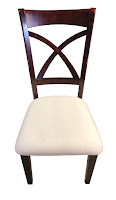 |
| Secretary Before |
 |
| Secretary After |
instantaneous with text messaging, e-mail and FaceTime, who wants to take the time to hand write anything? Yet, there’s something appealing to putting pen to paper and feel the words as they appear on your page. This antique mahogany secretary had been in the family for many years and had likely been witness to many such letters. It was probably used for bill paying, keeping track of household expenses and storing those stationary items to keep them accessible when you needed them. Because it was used quite a bit over the years, it was quite worn and needed refinishing. It’s hard to see in the picture, but the “after” photo shows new knobs, which were glass. (Unfortunately they don’t photograph very well.)
 |
| Secretary Inside After |
 |
| Secretary Inside Before |
Mahogany is one of my favorite woods to restore. It has such lovely patterns and tones that are rich with color and movement. This is a dream to strip and stain as it takes the new stain quite well. The interior also needed to be stripped, which is quite tedious because it had to come apart, otherwise you can’t reach those little cubby holes where envelopes are kept. It’s time-consuming work, no doubt about it. These things simply take a lot of time.
There are no shortcuts to quality work. This piece, like many of that period, was a perfect size for a small office and a tidy way to keep track of those pesky papers you don’t want cluttering up your table. After it was stripped, sanded and re-stained then protected with two coats of polyurethane, it was once again a lovely piece of furniture that will be useful for many generations to come.
































